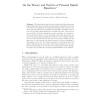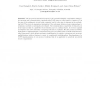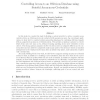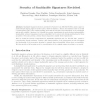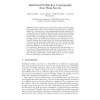PKC
2009
Springer
15 years 3 months ago
2009
Springer
We explore the security of blind signatures under aborts where the user or the signer may stop the interactive signature issue protocol prematurely. Several works on blind signatur...
PKC
2009
Springer
15 years 3 months ago
2009
Springer
We take a step towards a more realistic modeling of personal digital signatures, where a human user, his mobile equipment, his PC and a server are all considered as independent pla...
PKC
2009
Springer
15 years 3 months ago
2009
Springer
Abstract. We propose an asynchronous protocol for general multiparty computation with perfect security and communication complexity O(n2 |C|k) where n is the number of parties, |C|...
PKC
2009
Springer
15 years 3 months ago
2009
Springer
In this work, we consider the task of allowing a content provider to enforce complex access control policies on oblivious protocols conducted with anonymous users. As our primary ...
PKC
2009
Springer
15 years 3 months ago
2009
Springer
Abstract. The success of electronic authentication systems, be it eID card systems or Internet authentication systems such as CardSpace, highly depends on the provided level of use...
PKC
2009
Springer
15 years 3 months ago
2009
Springer
Sanitizable signature schemes, as defined by Ateniese et al. (ESORICS 2005), allow a signer to partly delegate signing rights to another party, called the sanitizer. That is, the s...
PKC
2009
Springer
15 years 3 months ago
2009
Springer
Network coding offers increased throughput and improved robustness to random faults in completely decentralized networks. In contrast to traditional routing schemes, however, netw...
PKC
2009
Springer
15 years 3 months ago
2009
Springer
This paper proposes a chosen-ciphertext secure variant of the ElGamal public-key encryption scheme which generates very compact ciphertexts for messages of arbitrary length. The ci...
PKC
2009
Springer
15 years 3 months ago
2009
Springer
Abstract.We introduce the notion of distributed password-based publickey cryptography, where a virtual high-entropy private key is implicitly dened as a concatenation of low-entrop...

